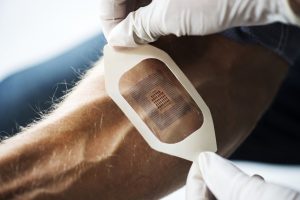Wearable devices have become ubiquitous in our lives and “wearables” has become a household name in recent years. Historically speaking, eyeglasses — first introduced in the 13th century — might have been the original wearable device, but the technology has come a long way since that invention.
The Modern Wearable
The term “wearables” encompasses a wide range of wearable technology and electronic devices that can be worn hands-free, embedded into accessories and fabrics, tattooed on or adhered to the skin or even implanted inside the body. Wearable devices have sensors, including motion, that track information in real-time, many of them transmitting it wirelessly via the internet.
Modern wearables are sophisticated devices powered by the microprocessor, many with wireless internet connectivity. Rapid evolution of wearable devices was made possible by miniaturization of microprocessors and growth of high-speed mobile networks. This rapid growth also coincided with the rise in the Internet of Things (IoT) technology.
Wearable Device Applications
The applications for wearable technology are wide ranging. From the early uses in the military and the space program, to fitness trackers, smart watches and head-mounted displays, to ever-increasing use in medicine and healthcare, the field of wearables is exploding. At the Consumer Electronics Show (CES) in January 2020, health care was the fastest growing category with a 25% increase from the prior year. Wearables were a star of the show, with many new form factors and use cases on display.
Wearables During the Coronavirus Pandemic
Wearable medical devices are changing the medical technology landscape, a growing trend that has been further accelerated by the global coronavirus pandemic. In less than a year, COVID-19 has altered our individual and collective behaviour, changing both healthcare and workplaces. Technology offers tools to meet these new challenges. When it comes to health, work and economics in the era of COVID-19, wearables have a role to play in the entire continuum of care, as well as in our work and leisure lives.
Wearables for Early Disease Detection and Population Health
Good population health approaches and personal hygiene practices — like wearing face masks and handwashing — go a long way towards

helping to slow the spread of the coronavirus and flattening the curve of the pandemic. But beyond these measures, technology can be a powerful ally. Because wearables, including smartwatches, make hundreds of thousands of measurements per day, they make for powerful monitoring devices. We know that when a human body fights off an infection, there are some signs, including rise in skin temperature and elevated heart rate. By continuously measuring these, wearable devices could help alert us well before humanly perceptible symptoms appear.
New research shows promise in wearables’ ability to detect early coronavirus symptoms. Back in 2017, research from Stanford Medicine demonstrated that health data collected from wearables can help detect infectious illness days before any noticeable symptoms emerge. Recently, Stanford Medicine researchers, in collaboration with Fitbit and Scripps Research, have launched a new effort aiming to detect early signs of viral infection through data from smartwatches and other wearable devices. Another promising 2020 research study showed that Oura ring can predict COVID-19 symptoms three days before the onset of symptoms with more than 90% accuracy.
In addition to the ability of wearable technology combined with smart algorithms to warn an individual of the onset of their own infection, this could also be used at a population level to track contacts and potential infection transmission in communities, helping curb the spread of viral infections such as SARS-CoV-2.
Coronavirus Testing and Diagnostics
The global scale of the COVID-19 pandemic brought the need for scalable coronavirus testing into sharp focus. The decades-old multidisciplinary field of microfluidics offers some practical ways to aid in this pandemic. The field of microfluidics combines engineering, physics and nanotechnology with chemistry, biochemistry and biotechnology to design systems that can process super low volumes of fluids to preserve resources and achieve high-throughput screening and automation. There have been numerous advancements in microfluidic technology over the past several years, which is proving to be a timely development, given how important it is in the context of the global pandemic to gain immediate insights at scale without wide availability of traditional testing methods.
When it comes to COVID-19, microfluidic devices play an important role for point-of-care testing and diagnostics. Microfluidics make Lab-on-a-Chip (LOC) technology possible. LOC can be used in COVID-19 testing to offer specific answers and actionable insights without the need for complex in-office testing. With non-invasive and minimally invasive microfluidics, all the information needed can be obtained from a tiny blood sample. Compared to a more involved interaction during the medical office testing, reducing invasiveness is critical when aerosolized particles put patients and providers at risk of transmitting and being affected by the virus. LOC also makes the serology (antibody) testing for signs of a previous COVID-19 infection possible. While active COVID-19 testing capacity is still lagging in the US, antibody testing could identify individuals and populations that have had COVID-19. Understanding COVID-19 pervasiveness in our communities is important for public health and measures for enhanced coronavirus prevention.
Wearables in the Workplace
With tectonic shifts in how businesses operate amidst the global pandemic, our workplaces might never look and feel the same. Wearables have a role to play in helping people return to work safely and keeping them healthy in their workplace. For example, wearable technology can be used to track the proximity of employees to each other in order to ensure adherence to the social distancing guidelines. Another example is rapid COVID-19 testing on-site. We will continue to see expansion of capabilities and uses of wearables and microfluidic devices. Whether it is allowing employees to feel safe on the job, employers to ensure the health of their workforce, or other population health measures, these technologies will transform how we think about health and the workplace.
